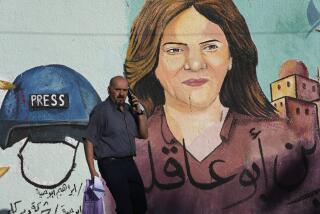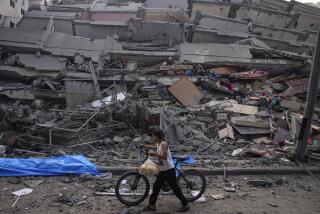Brother recalls texts from doomed Afghan journalist
- Share via
Reporting from Kabul, Afghanistan — The young Afghan journalist’s text messages to his elder brother were frantic at first, then eerily calm.
“Death is approaching,” he tapped into his mobile phone. “I am hiding.” And then, 20 minutes later: “If I die, pray for me.”
Ahmad Omaid Khpalwak, 24 years old and the married father of an infant daughter, was cut down by a hail of bullets this summer during a Taliban attack in Tarin Kowt, the capital of Oruzgan province. The bereaved family of Khpalwak, who was working for an Afghan news agency and the British Broadcasting Corp., believes that Western troops fired the fatal shots.
The incident points up the daily dangers faced by Afghans who work for foreign organizations, as well as Afghan civilians in general, particularly those living in a broad swath of Afghanistan’s restive south.
The July 28 Taliban raid, in which at least 19 people were killed, employed an increasingly familiar insurgent tactic: near-simultaneous strikes on a cluster of government installations by suicide bombers, backed by fighters with heavy weapons. Such strikes, often staged in broad daylight, have the effect of terrorizing residents and eroding confidence in the central government, even if the raiders do not succeed in overrunning the targets.
Western commanders say that such raids are a sign of desperation, reflecting an unwillingness by insurgents to directly engage NATO troops at better-fortified bases. But short of turning provincial capitals into virtual armed camps, officials acknowledge that little can be done to prevent such attacks, if Taliban fighters are willing to sacrifice their lives.
Ahmad Javed Khpalwak, 28, said his brother survived the initial noontime onslaught, a thunderous suicide blast near the radio and television building where he was working.
“I called him at exactly 12:06, just as the second explosion occurred,” the elder brother said in a telephone interview. “He pressed the OK button of his phone, but didn’t say anything [at the time]. I could hear firing.”
The Taliban — in line with usual practice — claimed responsibility for the attack even as the fighting was still going on. A Taliban spokesman, Qari Yousef Ahmadi, said the strike was aimed at a gathering of “the stooge regime’s officials” and their Western mentors.
As one explosion after another rang out, the elder brother counseled the younger by text message: “Try to get out of there.” But Ahmad Omaid, after an initial attempt to make his way outside, replied that he was trapped and hiding in a bathroom. He intended to try to wait out the fighting.
As the attack intensified, North Atlantic Treaty Organization forces provided aid, including air support to help repel the insurgents, according to Western military officials. Afghan forces are scheduled to take over security responsibilities within three years, but at this stage they have difficulty confronting larger attacks on their own.
When Ahmad Omaid, peeking out of the bathroom, saw NATO troops, he apparently thought he was safe, witnesses told his brother. He displayed his press credentials, which identified him as working with the Pajhwok news agency and the Pashto-language service of the British Broadcasting Corp.
“He tried to show his BBC and Pajhwok cards from a hole in the bathroom wall,” Ahmad Javed said, citing what witnesses told him. “A soldier … shot the hand holding them, and then fired 11 more bullets.” The family believes that NATO troops were simply unable to distinguish Afghan civilians from attackers, a scenario that often leads to noncombatant deaths and injuries in the heat of battle.
The elder brother, who lives nearby, had rushed to the scene, but says that when he got there, Ahmad Omaid was already dead, his body barely recognizable.
President Hamid Karzai expressed condolences to Khpalwak’s family, blaming “Afghanistan’s enemies,”the usual descriptive term for insurgents. Afghan journalist groups said it was unclear who was responsible, but called for a thorough investigation.
“Journalists are intimidated, hurt and killed by warring sides in Afghanistan,” Zia Bomia, head of an Afghan media-advocacy group, told reporters three days after the death.
For many Afghan journalists, the episode underscored the heightened danger they face as they work alongside Western reporters. Few have forgotten the 2007 beheading of Afghan translator Ajmal Naqshbandi, abducted by the Taliban along with an Italian journalist who was freed unhurt. Or the 2009 death of Sultan Munadi, an Afghan employee of the New York Times who was abducted, along with a Western colleague, and killed during a rescue raid by British forces. The other journalist survived.
Yaqubi is a special correspondent.
More to Read
Sign up for Essential California
The most important California stories and recommendations in your inbox every morning.
You may occasionally receive promotional content from the Los Angeles Times.













